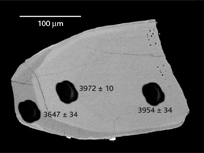A Tale of Early Earth Told in Zircons
+ Author Affiliations
No rock or mineral record has been preserved from Earth's “dark age”—the mysterious time after accretion of the planet about 4560 million years ago. Thanks to a continuous effort to find the oldest pieces of our planet, however, the duration of this unknown era is becoming shorter and shorter. Following the development of modern isotopic dating, the extent of the dark age was established at about 800 to 1000 million years by the discovery of exceptionally old rocks in western Greenland (1). The discovery of still older grains of zircon (zirconium silicate, a common if not very abundant component of crustal rocks, and an extraordinarily resilient mineral) in archean sedimentary rocks in Western Australia reduced the dark age to 400 to 300 million years (2, 3) and recently to less than 200 million years (4), a mere 5% of Earth's life span. That this was an eventful time is clear from studies of the Moon and Mars, where internally driven magmatism and differentiation ceased quickly or slowed down. We know that the processes that shaped further evolution of these bodies—large-scale mantle differentiation and formation of the primary crust—were occurring within the first few hundred million years.
On page 1947 of this issue, Harrison et al. (5) report their use of some of the oldest known zircons to explore the prehistory of the source rocks of these minerals. Their approach relies on the slow radioactive decay of the rare isotope 176Lu to 176Hf (half-life 37 billion years). This decay process increases the ratio of 176Hf to other isotopes of hafnium, usually expressed as 176Hf/177Hf. The rate of growth of the 176Hf/177Hf ratio is proportional to the Lu/Hf ratio. In geochemical studies, the 176Hf/177Hf ratio in a mineral or rock is expressed as a deviation from this ratio in bulk silicate earth (thought to be broadly similar in composition to, and determined from, chondritic meteorites). This deviation is measured in parts per 10,000 and is denoted as ϵHf(T), where T is time. When primitive mantle differentiates to form continental crust (a cover of less dense aluminum- and silicon-rich rocks) and depleted mantle (the more dense and refractory magnesium- and iron-rich residue left after extraction of crust-forming melts), the depleted mantle acquires a Lu/Hf ratio several times that found in crustal rocks. As a result, the 176Hf/177Hf ratio in the mantle grows faster than in the crust and ϵHf(T) becomes positive, whereas the complementary crust develops more and more negative ϵHf(T). When a melt derived from ancient crust or depleted mantle crystallizes and zircon is formed, the 176Hf/177Hf ratio in the melt is imprinted in the zircon and remains nearly unchanged over billions of years, owing to the low Lu/Hf ratio and high concentration of Hf in zircon (about 1%). If we measure the present-day 176Hf/177Hf and Lu/Hf ratios in the zircon crystal and determine the age of the zircon by decay of uranium isotopes to lead, we can trace the growth of the 176Hf/177Hf ratio backward and determine when primitive mantle separated into crust and depleted mantle. Alternatively, if the time of mantle differentiation is estimated independently, we can calculate the Lu/Hf ratios in the crust and depleted mantle, and try to infer the nature of these early Earth reservoirs by comparing these ratios to the Lu/Hf ratios measured in younger rocks of various compositions.
This zircon crystal from Jack Hills, Western Australia (length 0.3 mm) contains a rim that is younger than the central part by 300 million years. The brightness in this image, taken in backscattered electrons, reflects the difference of average atomic mass (heavier is brighter) due to variable concentration of hafnium, uranium, thoriuim, and rare earth elements—the most common minor components of zircon. The ages (in millions of years) were determined by SHRIMP (sensitive high-resolution ion microprobe) U-Pb analysis, similar to the dating technique of Harrison et al.(5). (The black spots are sites of the ion microprobe analyses, where the charge-dissipating gold coating was removed by ion bombardment.)
CREDIT: P. HUNT/GEOLOGICAL SURVEY OF CANADA
Most 176Hf/177Hf values determined by Harrison et al. (5) are close to or slightly below the primitive mantle evolution line, as would be expected for crustal rocks extracted from the mantle shortly before formation of the zircons. Some of the oldest zircon grains, however, plot well above or below the primitive mantle evolution line and require extreme fractionation of lutetium and hafnium and very early separation of their source rocks from the primitive mantle, probably around 4500 million years ago—less than 100 million years after the accretion of Earth. This result is interpreted by the authors as evidence for large-scale mantle differentiation and possibly an onset of plate tectonic activity between 4500 and 4400 million years ago. Whether the plate processes operated on a global scale or locally remains to be determined.
The report by Harrison et al. opens up many new questions. The first is the possibility that ϵHf(T) in zircon can be erroneously high or low if the zircon crystal includes domains that grew at different times (see the figure). Coexistence of domains with different ages within one crystal, very common in zircon, is the opposite side of the exceptional resistance of this mineral. If a zircon gets into magma, new layers can grow around the original crystal. The new zircon layer can have a chemical and isotopic composition different from the composition of the original crystal. Because the concentration of uranium and radiogenic lead (the decay product of uranium) can be quite different between the two domains while the concentration of hafnium remains relatively constant, the ages of the two components in a complex zircon crystal do not mix in the same proportion as their hafnium isotopic ratios. The 176Hf/177Hf ratio in zircon is arrested because of low Lu/Hf, but the 176Hf/177Hf in the reference reservoir (primitive mantle) evolves more rapidly. Hence, the use of a wrong age produces an erroneous ϵHf(T) that can mimic mantle differentiation. To avoid this problem, we need to study the internal structure and age distribution in ancient zircon in great detail. More reliable hafnium isotope data could be obtained from crystal domains that are shown to be homogeneous. However, analysis of these small crystal domains produces less precise data. Further progress in early Earth studies thus requires more sensitive and precise mass spectrometers for measuring 176Hf/177Hf ratios.
A fundamental uncertainty is whether the bulk silicate Earth indeed has the same Lu/Hf and 176Hf/177Hf ratios as the accepted reference that is based on analyses of chondrites. Recent discovery of a difference in the Sm-Nd isotopic system (a geochemical cousin of Lu-Hf) between chondrites and Earth (6) raises the possibility that our planet and undifferentiated asteroids (the source of chondritic meteorites) were assembled from different reservoirs of matter that never completely mixed with each other. Moreover, the Lu/Hf ratios in chondrites are variable (7, 8), and this makes choosing the accurate reference value for the bulk Earth even more difficult. The choice of bulk silicate Earth parameters would not change the spread of the earliest hafnium data, but it would change the proportion of those that show enriched crustal versus depleted mantle signatures. It also affects the mass balance of known reservoirs in the present-day Earth. Currently accepted parameters imply that these reservoirs are not in balance, which suggests either that the parameters are wrong or that there is an unknown reservoir that has sequestered lutetium and hafnium. Thus, the key to understanding the evolution of Earth's mantle and continents over time is establishing the precise chemical connection among Earth, meteorites, and the solar system as a whole, represented by the composition of the solar photosphere (9).
A final and perhaps most intriguing question is the mechanism whereby the signatures of extreme differentiation in the mantle-crust system during the first 500 million years were almost completely erased. Although there is some evidence for early differentiation in the oldest rocks, the average 176Hf/177Hf evolution curve defined by most mantle-derived rocks over the rest of Earth's history diverges from the chondritic curve at about 4 billion years, which is when the rock record begins (10). Something reset the clock on a planetary scale. On the basis of the lunar record, a period of massive meteorite bombardment is thought to have occurred at that time. If so, it must have induced homogenization of mantle and crust on a scale vastly greater than can be explained by recent plate tectonic processes. We are indeed fortunate that the fragmented memory of an earlier time has survived in the form of zircon crystals.


